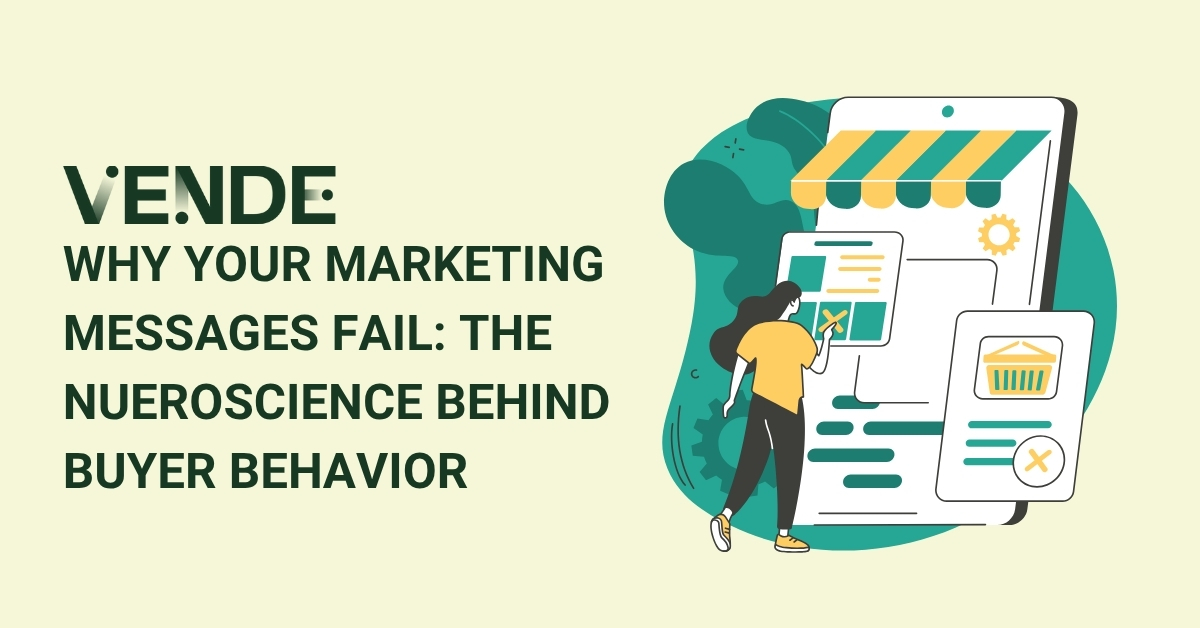
How to Create Content that Generates Demand for Your Business
Learn our 6 step content marketing framework to build content that generates demand and grows your pipeline
Prospects consume words to help them learn and solve problems. It’s that simple. However, many B2B companies struggle with writing content that generates demand and draws the attention of their buyer to their products and services.
According to research from Demand Gen Report, over 60% of B2B marketers rank content marketing as a top tactic for connecting with prospects and generating traffic, leads, and sales.
Content marketing works because buyers need information to help them prioritize their work and make good purchase decisions. The payoff can be huge if your content influences a buyer's thinking on how to move forward. According to TechTarget, 91% of B2B companies ultimately purchase from the organization that was first to provide valuable information.
But how do you stand out in a crowded and saturated marketplace? Buyers’ inboxes are full of all kinds of information and offers. When they go online they are assaulted by brands vying for their attention.
In this article, we will share 6 steps for building a demand gen content marketing strategy to engage your buyers the right way in the right channels.
What is Demand Generation Content And Why Does it Matter?
Demand generation content is content that has been created specifically to attract and educate targeted buyers while demonstrating your company’s expertise. The goal of this valuable content is to establish your company as a preferred vendor when buyers consider purchases within your category. For content that generates demand to work, it must make the reader stop, think, and respond.
Guiding Principles for Creating Great B2B Demand Generation Content
Think of B2B Demand Gen content marketing like laying a trail of breadcrumbs that wind prospects down a path to enlighten them on how your company can help them achieve goals. Along the way, you create awareness, add value, and educate them on features of your offering that are true differentiators. This establishes your business as an authority and, in most cases, results in you becoming the preferred vendor.
Follow these guiding principles to create really compelling content that your prospects will love:
- Really know your audience - one of the biggest mistakes in marketing is not understanding your customer’s pain or problem beyond a superficial level. You must invest the time to identify your Ideal Customer Profile (ICP). This is the niche or sub-market that you serve best. Focusing on a single ICP enables you to deeply understand the specific pain you can solve for their business.
- Stay in your lanes - marketing is an exercise in memorization and your content must focus on just a handful of topic categories that align with your capabilities to solve problems and achieve better outcomes. If not, you’ll dilute your message.
- Create momentum for the buyer - buying is actually harder than marketing/selling. You have to spend the time to really understand the buying journey and what information the buyer needs to make a good purchase decision. You create momentum by developing content that educates and aids the buyer at each stage of their journey.
- Repurpose & distribute like a madman - your content must be repurposed, sliced & diced, and promoted across the web in every relevant channel. It’s not once and done; it’s create once and distribute always.
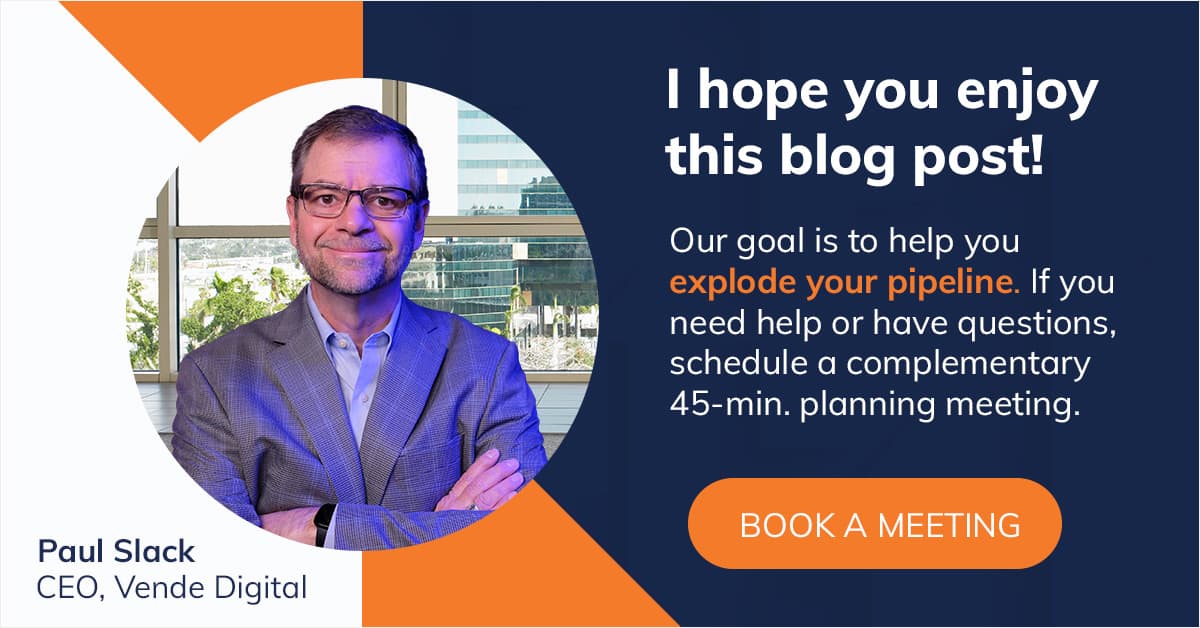
6 Step Content Marketing Framework
When creating demand, your story doesn’t begin with your products; it leads to them. The buyer needs to think differently about their business before they think about your solution. The goal of your content should be to communicate, “Hey. There’s a better way. Let me show you how.”
Follow these 6 steps to create content that attracts, engages, and motivates your prospects in a way that establishes your business as the preferred vendor.
Step 1: Identify 3-4 Content Pillars
Think of Content Pillars as stakes in the ground. Carefully choose three or four categories of content that connect the dots between your ICPs problems or desired outcome and your superpower(s). These content pillars will become the foundation for all of the topics you will identify in step 2. Don’t stray from these pillars or you will end up watering down your message.
Brainstorm with your team and talk with customers to identify your top 3-4 content pillars. Ask these questions to get the ideas flowing. As an example, I’ve also provided how Vende Digital answered these questions for our business:
- What are the desired outcomes our ICP is looking for?
- Vende Digital Example: More revenue, more pipeline growth, more leads
- How would our ICP describe what we do?
- Vende Digital Example: B2B digital agency, demand generation agency, performance marketing agency
- What problems are prospects struggling with that align with our solution? Look for problems that have high pain points and are relatively easy to solve with your solution.
- Vende Digital Example: Developing/executing a digital strategy that generates leads and pipeline growth, developing/executing a content strategy that engages buyers, getting sales reps involved in social selling the right way, improving website UX/conversion rates
- What does their business look like when they have solved their problem with our solution?
- Vende Digital Example: Predictable pipeline/sales growth, content that drives engagement/traffic/leads, sales reps that are equipped to win in social media, happier customers.
- What could we teach our ICP about their business that would lead them to better results?
- Vende Digital Example: You must have a full-funnel demand generation strategy and not just a lead generation strategy to win clients. You must be consistently in-market to get the awareness you are looking for. You must leverage your sales team, subject matter experts, and C-Suite to engage in social media as part of your demand generation strategy. Your website is for prospects to learn and buy; not for you to sell.
- What is hurting our ICP that they may not be aware of?
- Vende Digital Example: Wasting money on bottom-of-the-funnel campaigns, keeping useful knowledge locked up in the heads of their SMEs, having sales reps act like used car salesmen in social media, having too much content, and poor copy on their website.
Once you go through this exercise, review your answers and find the key concepts that seem to rise to the top. Run these by existing customers to lock down the 3-4 that work best.
For example, at Vende Digital our content pillars are:
- Our Category: B2B Digital Marketing/Demand Generation/Lead Generation
- Content Marketing
- Social Selling
- Frictionless Buying Experience (UX)
Step 2: Developing Relevant Topics
The topics you write about need to create momentum with prospects. Here are some useful ways to flush out topics that matter to your readers:
- Develop topics around the steps, challenges, and obstacles a prospect needs to work through to get from where they are today to the transformation (better tomorrow) they are looking for. Ask yourself:
- If they were to solve this problem on their own, what steps would they need to take?
- What are the symptoms or signs that show the prospect has a problem?
- How are prospects dealing with the problem today?
- How is that a poor alternative compared to your better way?
- What are myths or misconceptions about your pillars?
- What stories or evidence do we have to show/prove our value?
- This exercise is great for “how-to,” “best practices,” “mistakes to avoid” content. For example, this article is a “how-to” piece related to content marketing. Other examples include: The Essential “How To” Guide For B2B LinkedIn Lead Generation, How to Create Landing Pages that Convert, 3 Common B2B Digital Advertising Mistakes and How to Avoid Them
- Type your content pillars into Google to identify related topics. The suggestions Google serves up come from how people actually search for the pillar term. In the example below, you can see all the different ways our prospects search for information related to “Demand Generation.”
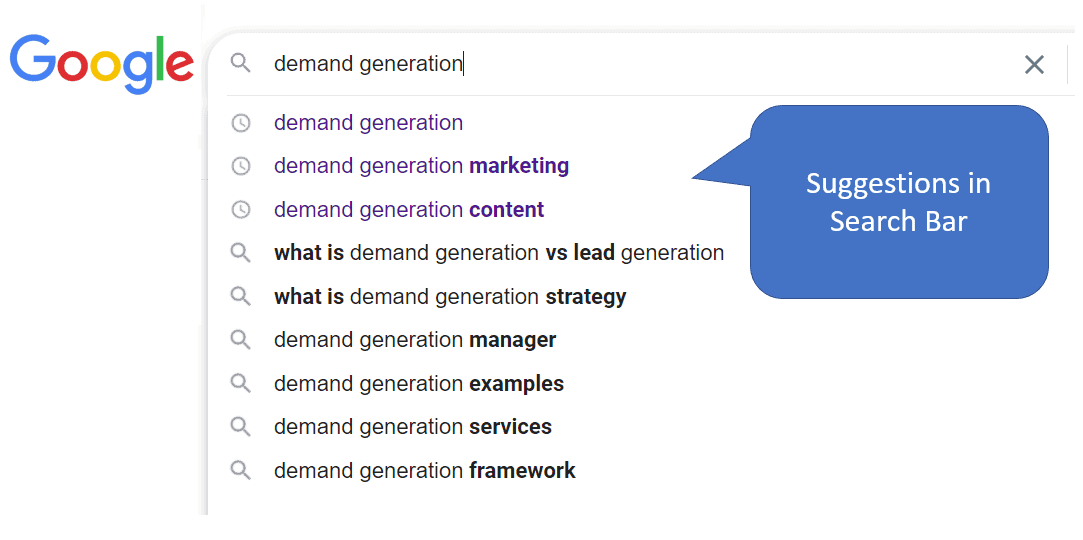
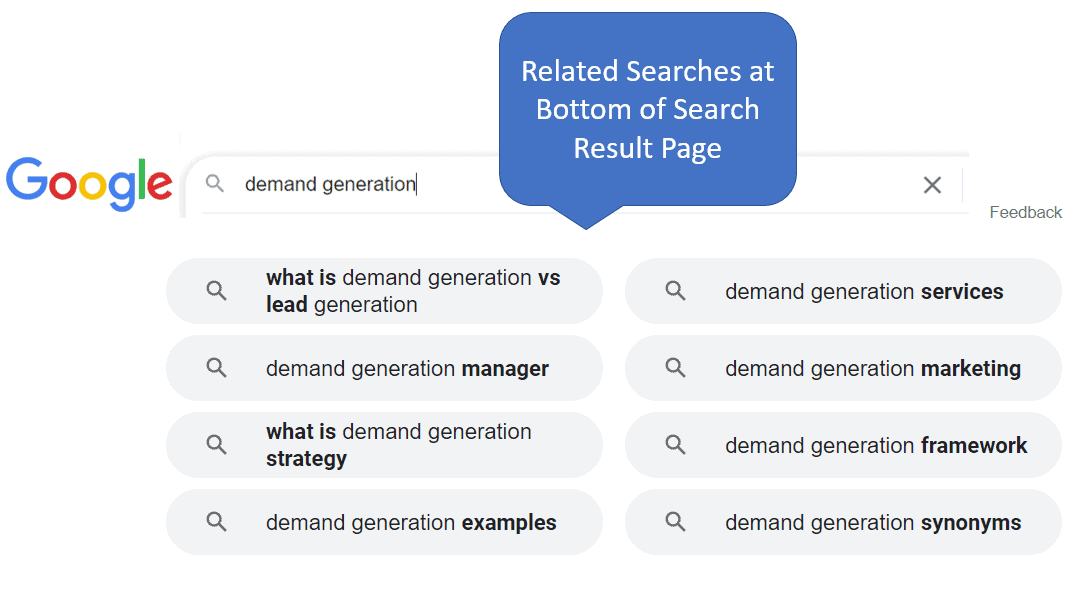
- While you are in Google, do a search for “top challenges for [Your Prospect] in [Current Year].” This will yield a search result of more challenges than you could ever write about. Make a list of all of the relevant challenges and turn them into interesting topics. For example, here are some interesting challenges I discovered related to our prospect (CMO):
- CMO Challenge: Understanding buyers’ changing needs and business requirements - Becomes Topic: XX Practical Steps to Discover Your Buyers Needs and Business Requirements
- CMO Challenge: Engaging buyers at the right time in the right channel - Becomes Topic: How to Engage Buyers At the Right Time in The Right Channel
- CMO Challenge: Creating personalized campaigns and content that will engage buyers - Becomes Topic: The Ultimate Guide to Creating Personalized Campaigns to Engage Buyers
- Interview the sales team and find out the most common questions that arise during the sales process and the top 3-5 reasons why people don’t buy from you. Your demand generation content needs to answer common buyer questions and deal with objections before a prospect engages with your sales team.
- Finally leverage tools like BuzzSumo and AskThePublic for expanding your content pillars into even more topics.

Once you have great topics picked out from your research, you’ll need to come up with catchy headlines that will grab the attention of your prospect. We have a great (ungated) resource for you. The 100 Topic Suggestions Worksheet. It’s like Madlibs for content marketing. Be sure to check it out.
Less is more here. It is better to create fewer solid content items tied to your Pillars that are really helpful for the buyer than to create a lot of watered-down fluff pieces. For example, at Vende Digital, we write 1-2 blogs each month like this one. However, it is critical to repurpose your content into formats that matter to your ICP. In the chart below, you’ll see all the different formats that are consumed by B2B buyers at different stages. We’ll discuss this in more detail in Step 4.
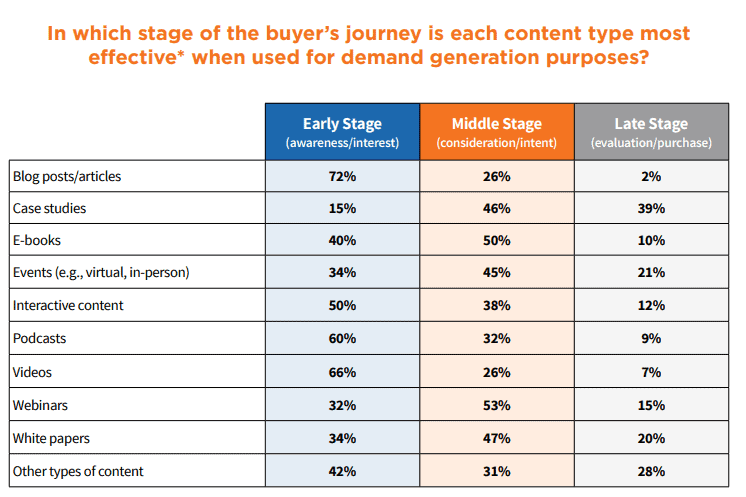
Step 3: Write Remarkable Content
Your content marketing strategy will make or break on this step. You’ve done the homework and have plenty of interesting topics that align with your content pillars, now it’s time to create content that will actually inspire, inform, and motivate your reader. The problem/opportunity is that most of the content consumed by your prospects sucks. Follow this process to create content that doesn't:
- Prepare and outline by asking these questions:
- What do you know about this topic?
- What is changing that the reader needs to know about this topic?
- What is being missed or overlooked by our reader related to this topic?
- What are the common problems/challenges your reader experiences related to this topic?
- What are the actions they should take to get there?
- What does life look like if they don’t solve this problem now?
- What are the outcomes if the reader gets this right?
- How does this topic connect to our superpower?
- What are 3rd party stats that we can reference?
- Develop a common structure for your content. This will help you scale and develop content more efficiently. Here is my framework for writing an article:
- Headline - Include a hook and a key phrase; our topic suggestion worksheet can help with this.
- Opening - Introduce your topic, paint a picture, and sprinkle some curiosity to entice the reader to keep going.
- Body Point(s) - Try to work in each of the following elements:
- Subhead to introduce the point
- Problem - what’s the problem as it relates to the topic
- Proof - how can you validate you point
- How to solve/steps to take - these need to be simple to understand and implement
- Example - drive the point home with a relevant example
- Close - Restate the main point, tell the reader what life will be like when they take action on the main point, offer key takeaways, and present a question, challenge or call to action.
- Finally, make sure each content piece is high-quality by asking these questions before you publish:
- Does this move the prospect forward (create momentum)?
- Does it teach them something new?
- Will they feel differently about our company, or was our value reinforced?
- Here are some additional articles to help get you started
Step 4: Repurpose Your Content
Step 3 is the hardest part of the framework and so many marketers stop there. Once the content is published they feel like they’re done. This is a huge missed opportunity! Repurposing content multiplies the results of your development efforts exponentially to make sure you are truly developing content that generates demand.
Break your long-form content (blogs, webinars, ebooks, case studies, keynotes, podcast interviews, etc.) into mico-content that can be delivered in multiple channels and formats. Here is a simple formula to get started:
- Start with a topic like The Ultimate Buyers Guide to [Your Category]. This guide should educate your buyer through the process of solving their problem with your category first (for example Demand Generation for Vende) and ultimately your solution.
- Come up with the outline for this guide. The outline becomes a content plan for blog topics.
- Write a blog for each topic that came from the outline.
- Create a video that summarizes the blog content. This can simply be someone recapping the key points or an animated summary video.
- Take the key points within the blog articles and convert them into multiple social posts.
- Once you have written articles on all of the topics, you will have enough content to actually create the Guide. You can decide if you want to gate the guide as a downloadable pdf or keep it ungated on your site.
- Extra Credit: Turn the guide into a video course.
- Resources to help: Lately.ai is an AI tool that can help you convert blog content into social posts. Lumen5 is a tool for converting blog content into animated videos. Repurpose House offers a more hands-on service to help you convert content.

Step 5: Distribute Your Content Where Buyers Go to Learn
Distributing your content is just as important as writing it. Now that you have awesome content that will aid the buyer, you need to get it out there. The key here is to enlighten your audience in channels where they go to learn, communicate your value proposition, and ultimately drive them to your longer-form pillar content. There are four ways to do this and you should incorporate each into your distribution plan.
- Paid distribution - Paying to distribute your content on sites like LinkedIn works great because it provides guaranteed delivery of your content to your ICP. For example, we continually drive highly qualified impressions and traffic for our clients for less than $2 CPC. Paid content distribution truly is a B2B advertising best buy.
- Organic distribution - Start by promoting your content on your branded social channels. For maximum impact, get your Subject Matter Experts (SMEs) and sales reps to share the content with their connections.
- Email - Email your opt-in list with your new content. These are folks who have raised their hand and said “give me more.”
- Influencers - We’re not talking about the Kardashians here; but rather who has the ear of your buyer? These are the folks who need to be sharing your content. One of the best ways is to get your SMEs on the podcast circuit.
Step 6: Update Old Content
Keep your content fresh and up to date to keep buyers coming back. Old content can often begin to slip in search results and get out of sync with current messaging and buyer needs. Here is a simple checklist to follow to create content that generates demand:
- Start by identifying targeted pages using a key phrase position report to find pages that may be dropping in the search results for targeted key phrases.
- Do a search for the topic in google and get headline inspiration by reviewing the articles that show up near the top.
- While on the search result page look at the “people often ask” section and see if there is a good question that can be incorporated into the article.
- Review the Title and Description tag to make sure they are compelling.
- Review our content writing framework in Step 3 and see if you can punch up the copy and make it more about the buyer's needs.
- Look for places to interlink the content with new pillar content.
- Add multimedia (video, infographics, stats, etc.)
- Don’t change the URL! This will hurt your search rankings.
- Congratulations; you now have new content to repurpose and distribute. Treat it like a new piece of content by working through Steps 4 and 5 to complete the process.
Use Content Marketing to Aid the Buyer and Grow Your Business
It ultimately comes down to words. Prospects are either going to read your words or someone else’s to help them make well-informed decisions. The good news is that, like you, your competition is struggling to create and distribute high-quality content. Following this 6 step framework will help you jump ahead and get the attention of your buyer before they do. This will establish you as the preferred vendor and win more business.
Key B2B Content Marketing Takeaways:
- Content marketing is critical for any demand generation marketing strategy.
- Offing valuable content will establish your company as a preferred vendor when buyers consider purchases within your category.
- Great content starts from knowing your buyer and their problems really well.
- Focus topics around key pillars to keep your message on point and aligned with your superpower.
- Repurpose and continually distribute content in multiple formats and channels for maximum impact.
- A good content marketing plan should feed your social media marketing plan.
How Can We Help?
Finding the time to build and execute a content marketing strategy like this can be challenging. If you’d like help thinking through and implementing a successful B2B Demand Generation marketing effort, schedule a complimentary discovery meeting with our team. We’ll take the time to learn about your business and give you an action plan on how to achieve your goals.




